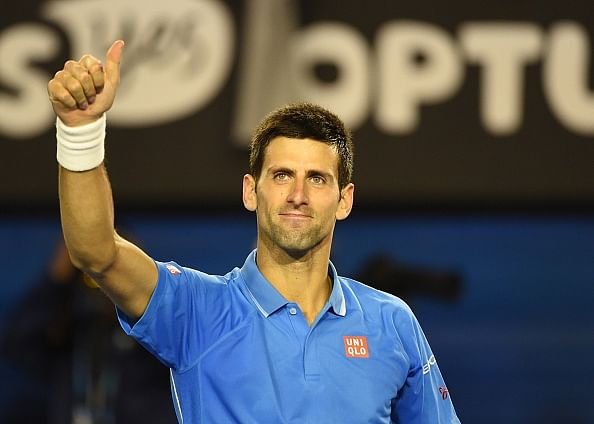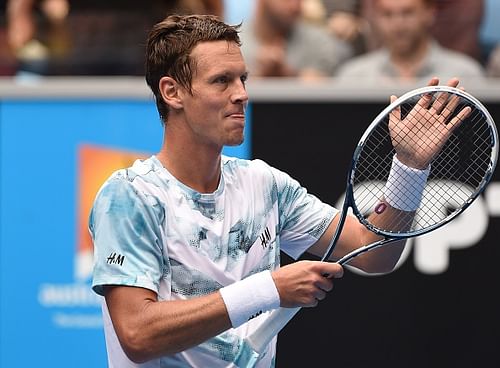
Australian Open Diary: Stories in the draw
And then there were eight.
We are officially at the business end of the Australian Open, with the initial field of 128 players in both the men’s and women’s draws now whittled down to the final eight. The days ahead promise some absorbing contests, and will, in all likelihood, give us some useful pointers on what to expect from the tennis year ahead.
But even before we sit down for the Big Matches, here is a closer look at the remaining drawsheet for the quarterfinals. After all, making it to the top eight in a Grand Slam is no mean achievement in itself, and this is also the stage of the tournament where patterns begin to fall into place – a few good matches becomes a deep run, and new names get embedded deeper in our consciousness.
So what do our quarterfinalists tell us, and what do their match-ups mean for the rest of the tournament and the year ahead?
The men’s quarterfinals:
Novak Djokovic (1) vs Milos Raonic (8)
Rafael Nadal (3) vs Tomas Berdych (7)
Stan Wawrinka (4) vs Kei Nishikori (5)
Andy Murray (6) vs Nick Kyrgios
The women’s quarterfinals:
Serena Williams (1) vs Dominika Cibulkova (11)
Maria Sharapova (2) vs Eugenie Bouchard (7)
Simona Halep (3) vs Ekaterina Makarova (10)
Venus Williams (18) vs Madison Keys
The top remains hard to dislodge

In the men’s draw, 7 of the top 8 seeds remain. This may come as no real surprise given the consistency of the top men’s players, especially in Grand Slam play. But what it does tell us is that in a period where talk of the Big 3’s (or 4’s) demise continues to gain momentum, the next generation of stars, a la Nishikori and Raonic, are proving to be a safe bet at the business end of tournaments as well.
In the women’s draw, 4 of the top 8 seeds remain. Even this seems like a strong statement for stability, given how chaotic the women’s draw in a Grand Slam can sometimes look. As has been the case for some time now, it is Serena Williams, followed by Sharapova, who lead the charge for consistency at the top.
The lone young guns

Both draws have a solitary unseeded player making it through to the quarterfinals. For the men, it is Nick Kyrgios, local hero and survivor of a couple of epic battles in the tournament already. For the women, it is the American Madison Keys, who has dropped just one set in the tournament so far.

Both players are still teenagers at 19 years, and have a powerful game built around a strong serve. While Kyrgios’ breakthrough came in his defeat of Nadal at Wimbledon 2014, Keys might have had her finest moment (so far) in her efficient dismantling of the fourth seed, Kvitova, in the third round here. In fact, the confident way in which Keys served out the final game in her victory over Kvitova was quite reminiscent of Kyrgios doing the same to Nadal last year.
Both players have the weapons for the big stage, and seem like long-term prospects. The best compliment for them is that it would not shock anyone if they managed to make their way even further in this tournament.
Coaches to the rescue

The Australian Open, coming as soon as it does after the off-season, often proves to be the initial test of coaching changes effected at the end of the previous year. This time around, there have been quite a few high-profile changes made in the coaching merry-go-round. Happily for most of the players with new coaching staff by their side, they find themselves in the final eight of the year’s first Grand Slam. The changes seem to be working, or at least, not backfiring so far.
On the men’s side, Andy Murray decided to repose greater faith in Amelie Mauresmo and ended his long association with Dani Vallverdu. Vallverdu, in turn, was immediately picked up by Tomas Berdych, who had earlier unsuccessfully pitched for Ivan Lendl. So far, the new arrangements seem to be working fine for everyone, with Berdych especially looking very sharp at this Open.
On the women’s side, Simona Halep made the move to the Romanian Victor Ionita along with a consultant in Thomas Hogstedt. And Eugenie Bouchard took the big step of no longer working with her childhood coach, Nick Saviano.
But perhaps the most impactful coaching move might be Madison Key’s association with former Wimbledon champion, Lindsey Davenport. Though not a full-time coaching arrangement, Davenport has been a constant feature in Key’s box at the Australian Open, and seems to be responsible, at least in part, for the young American’s sudden spurt in performance.
The only recent major coaching change which hasn’t quite worked yet is Agnieszka Radwanska teaming up with Martina Navratilova. That is a pity, because such a high profile team, if successful, could easily end up fuelling a ‘super coach’ phenomenon on the WTA tour, similar to Murray-Lendl for the ATP.
The best of them all

So who is looking the best among the quarterfinalists in this Australian Open?
On the men’s side, two players have won their four matches so far without losing a single set. World number 1 Novak Djokovic being one of them comes as no surprise. The Serb has looked fit, hungry and merciless in his matches so far.
The other player, in a mild surprise, is Tomas Berdych, who has looked completely at ease so far. Things may not be as straightforward in the next round though, where he is scheduled to meet Rafael Nadal.
On the women’s side, there are two players again who have not lost a set in the tournament so far – Ekaterina Makarova, who has some wonderful memories from Australian Opens in the past, and Simona Halep, still in the hunt for her first Grand Slam title. The invincible tournament run will definitely end for one of them, as they are scheduled to meet each other in the quarterfinal.
So who is truly the best among them all? Does an unbeatable run in the first week indicate championship likelihood? Or do long early battles only toughen you up for the big matches ahead?
All will be revealed over the next few days. We can only wait and watch, as the Australian Open winds towards its blockbuster final weekend.